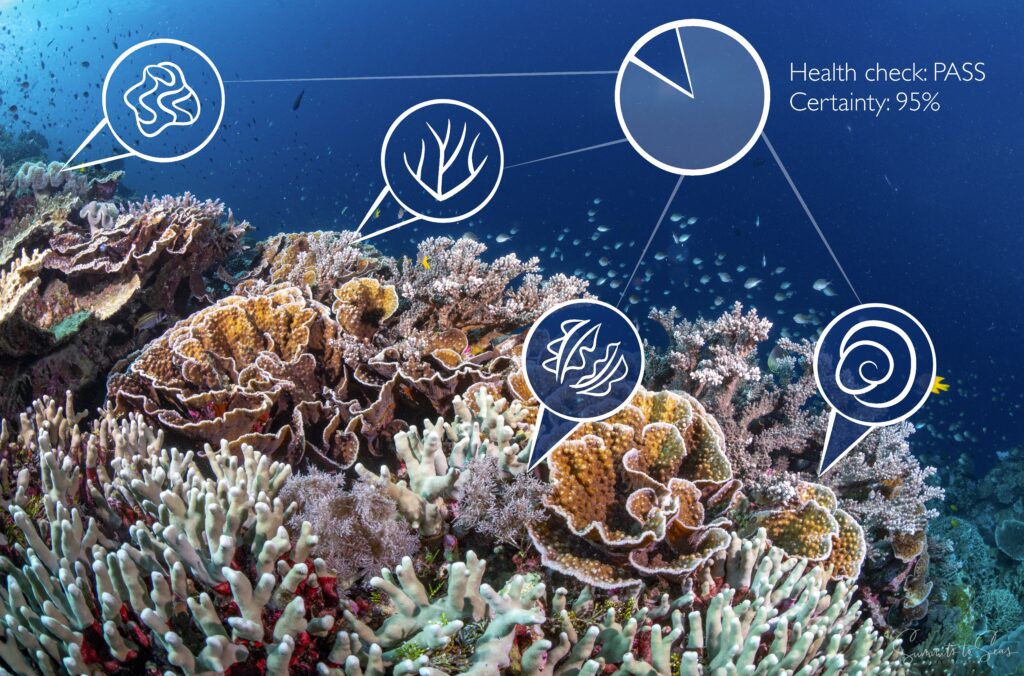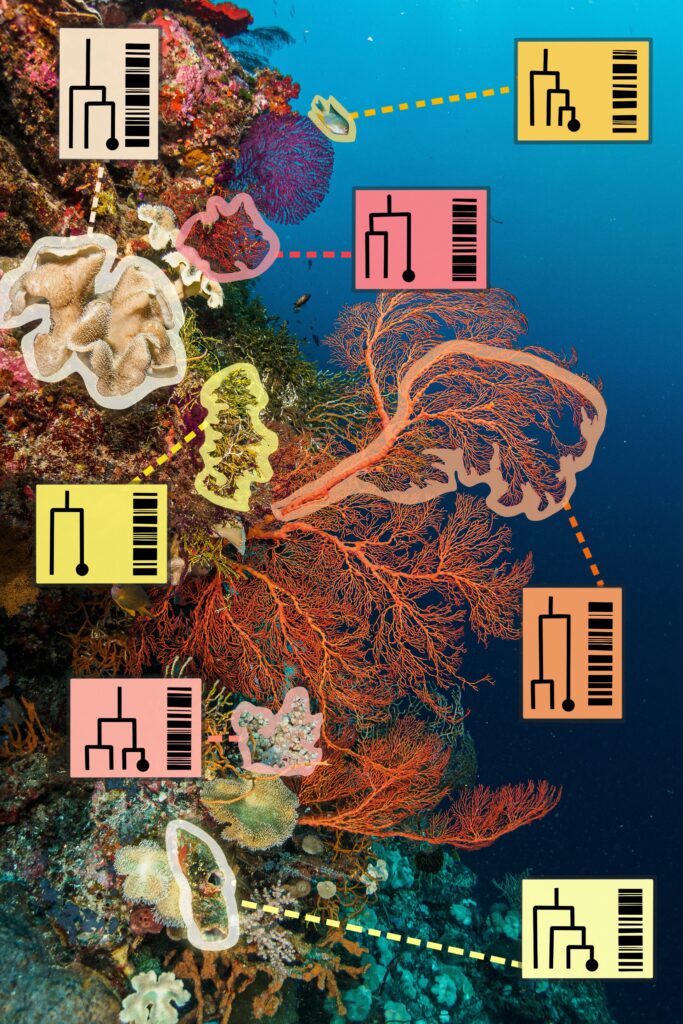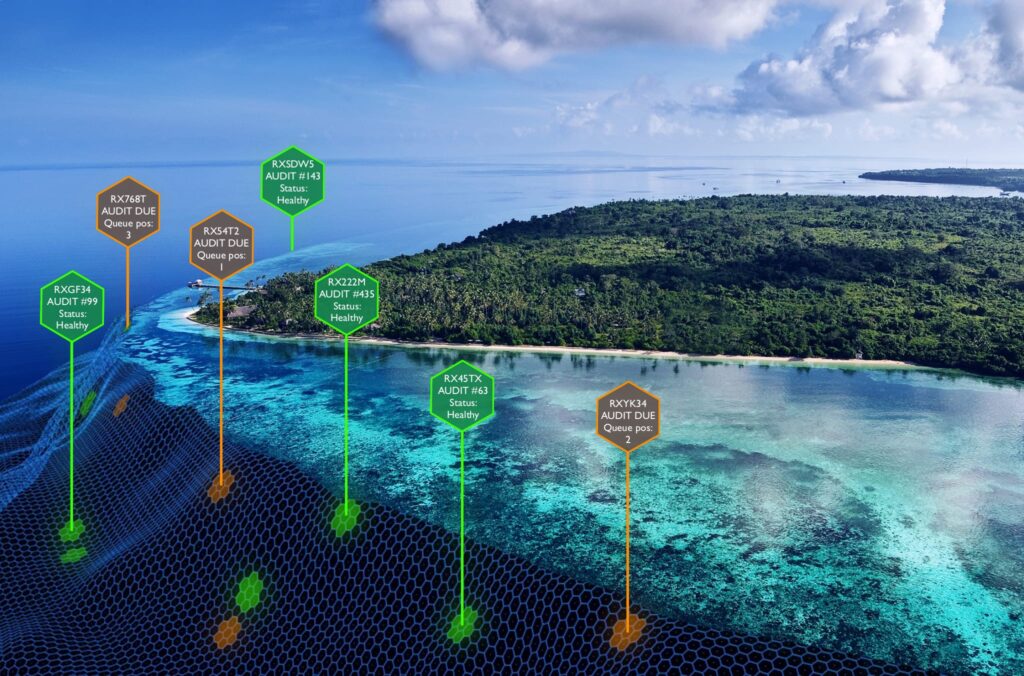While designing our reef health monitoring programme, our goal was to devise a suite of techniques that we could deploy, at scale, to reliably measure ecological outcomes.
We needed to avoid falling into some common traps. One is not selecting biologically meaningful metrics. Coral restoration efforts, for example, often use coral cover as a proxy for biodiversity-supporting capacity. This is a convenient metric if you are planting lumps of coral, but one that grossly over-estimates the capacity of a staghorn coral monoculture to support life. Using the same metric in a terrestrial system would lead us to conclude that a golf green can support the same abundance and variety of life as an ancient rainforest.

A second pitfall is doggedly diverting resources to measurement, while failing to first ensure positive outcomes. The result is a meticulously documented decline. A bit like a doctor telling you that ‘the bad news is that you’re dying. The good news is that we’re 100% sure!’.
Sending teams of divers underwater with tape measures and plastic quadrats can be a great introductory teaching tool. It is difficult, however, to argue that these techniques have a place in tracking health across ecosystems that can stretch for over a thousand kilometres. In order to reliably measure the results associated with a conservation operation, it is important to establish an efficient and consistent way of discerning healthy from unhealthy habitat.
Reefonomics is in the business of delivering outcomes. This necessitates data collection and processing efficiency on a different scale.
Reefonomics has developed a monitoring programme that leverages modern ecological theory, technology and artificial intelligence to characterise and scan for the fingerprint of a healthy reef across, for example, the 20km of protected reefs in Wakatobi. This programme is ‘multi-sensory’, collecting information across multiple machine-sensory channels, examining the reef through machine eyes, eavesdropping on the soundscape and detecting invisible clues from water chemistry.
We have trained a machine learning model to visually characterise, with over 90% accuracy, the flora and fauna colonising the reef habitat from photo surveys. After the biodiversity of a reef cell has been classified, this output compared to index that classifies habitat health using stringent thresholds. This process allows us to catalogue the state of kilometres of reef habitat orders of magnitude faster than human observation would allow.

Machine learning model classifies the reef’s biological community.
Clues about an ecosystem’s inhabitants can also be elucidated from its soundscape. Just like a lush rainforest is alive with the sound of chirping birds, insects and rustling mammals, an intact reef generates a cacophony of biotic sound. By contrast, a degraded reef may have a denuded soundscape. By deploying hydrophones to capture the underwater acoustics of a reef, we can start to develop techniques to decode these sonic signatures, and gain insight into the activity associated with a reef.

eDNA analysis allows us to identify the exact genetic barcode of species inhabiting a reef.
The clear water that bathes reefs is actually a soup of genetic information, invisible to the naked eye. All organisms shed DNA into their surroundings, leaving a microscopic genetic fingerprint wherever they go, known as environmental DNA (eDNA). Sequencing eDNA that we filter from seawater samples allows us to decipher which species inhabit a particular reef area from their unique genetic barcode. This data contains a signature for habitat quality. We have seen an early indication that genetic material from rare and threatened coral species is concentrated only at the most diverse, richly populated reefs.
Seawater yields other clues about the state of a reef ecosystem. The physical and chemical properties of seawater, collectively referred to as ‘ocean weather’, influence, and are influenced by, the biological activities of a coral reef. Live sensors relay real-time ocean weather information, enabling us to monitor the metabolic pulse of the reef. Sunlight determines the balance between photosynthesis and respiration on the reef, driving daily fluctuations in water chemistry. The large fluctuations observed at Wakatobi are a sign of a metabolically active reef – another signature of a productive ecosystem.
Information from multiple sensory channels comes together to create a picture of the fingerprint of a healthy reef, that we can scan for efficiently and at scale, using artificial intelligence. This allows Reefonomics to robustly measure the outcomes associated with marine protection efforts at scale, against meaningful ecological metrics.

Reef health is audited throughout the protected area.
